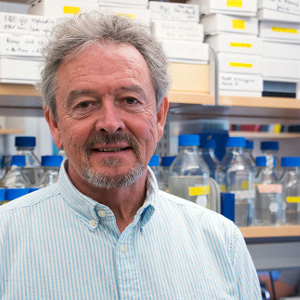Professor
Ph.D. University of Birmingham, UK, 1975
 326 Bartram Hall
326 Bartram Hall
(352) 392-5856
—and—
415 Cancer & Genetics Research Complex
(352) 273-7875
malcmaden@ufl.edu
Research Interests
I study the relationship between development and regeneration in various organ systems including the limb, the lung, the skin and the nervous system. The guiding principle of this research is that by comparing the signaling molecules that operate in these two processes we can determine whether there are any fundamental differences (is regeneration a process of re-development?) and whether we can induce regeneration by re-awakening developmental pathways. Much of this work is centered on one signaling pathway, that of retinoic acid and the organisms used range from axolotls (the champion of regeneration) to mice. Most recently we have discovered that the spiny mouse can regenerate its skin wounds perfectly by replacing hairs, sebaceous glands, dermis, smooth muscle and skeletal muscle and much of our work is now concerned with examining the regenerative properties of this remarkable regenerating mammal. We are studying the regeneration of skeletal muscle, the central and peripheral nervous system, the lungs and the heart in the spiny mouse.
Recent publications
Streeter KA, Sunshine MD, Brant JO, Sandoval AGW, Maden M, Fuller DD. (2020). Molecular and histologic outcomes following spinal cord injury in spiny mice, Acomys cahirinus. J Comp Neurol. 528(9):1535-1547.
Maden M. (2020). RA Signaling in Limb Development and Regeneration in Different Species. Subcell Biochem. 95:87-117. doi: 10.1007/978-3-030-42282-0_4.
Maden M, Varholick JA. (2020). Model systems for regeneration: the spiny mouse, Acomys cahirinus. Development 147(4):dev167718. doi: 10.1242/dev.167718.
Yoon JH, Cho K, Garrett TJ, Finch P, Maden M. (2020). Comparative Proteomic Analysis in Scar-Free Skin Regeneration in Acomys cahirinus and Scarring Mus musculus. Sci Rep. 10(1):166. doi: 10.1038/s41598-019-56823-y.
Sandoval A.S.G. & Maden M. (2020). Regeneration in the spiny mouse, Acomys, a new mammalian model Curr. Opinion Genet. Dev. 64, 1-6.
Maden M, Serrano N, Bermudez M. & Sandoval A.G.W. (2021) A profusion of neural stem cells in the brain of the spiny mouse, Acomys cahirinus. J. Anat. 238, 1191-1202. https://doi.org/10.1111/joa.13373.
Wong, W., Kim, A., Seifert, A.W.S., Maden, M., & Crane, J.D. (2021). Spiny mice (Acomys) exhibit attenuated hallmarks of aging and rapid cell turnover after UV exposure in the skin epidermis. PLoS One 15(10): e0241617. https://doi.org/10.1371/journal.pone.0241617.
Gaire, J., Varholick, J.A., Rana, S., Sunshine, M.D., Doré, S., Barbazuk, W.B., Fuller, D.D., Maden, M. & Simmons, C.S. (2021). Spiny Mouse (Acomys): an emerging research organism for regenerative medicine with applications beyond the skin. npj Regenerative Medicine 6, 1; doi.org/10.1038/s41536-020-00111-1.
QI, Y., DASA, O., MADEN, M., VOHRA, R., BATRA, A., WALTER, G., YARROW, J.F., ARANDA, J.M. Jr., RAIZADA, M.K. & PEPINE, C.J. (2021). Functional heart recovery in an adult mammal, the spiny mouse. Int. J. Cardiol. https://doi.org/10.1016/j.ijcard.2021.06.015
POLVADORE, T. & MADEN, M. (2021). Retinoic acid receptors and the control of positional information in the regenerating axolotl limb. Cells 10(9):2174. doi: 10.3390/cells10092174.
MADEN, M. & POLVADORE, T. (2022). Retinoic acid-induced limb duplications. In ‘Salamanders. Methods and Protocols”, A.W. Seifert & J.D. Currie eds., Methods in Molecular Biology, pp 249-258, Humana Press.
MADEN, M. (2022). Salamanders as key models for developmental and regeneration research. In ‘Salamanders. Methods and Protocols”, A.W. Seifert & J.D. Currie eds., Methods in Molecular Biology, pp 1-23, Humana Press.
SANDOVAL, A.S.G., MADEN, M., BATES, L.E. & SILVA, J.C.R. (2022). Tumor suppressors inhibit reprogramming of African spiny mouse (Acomys) fibroblasts to induced pluripotent stem cells. Wellcome Open Research 7:215.
CHAN, K.M., THURLOW, N.A., MADEN, M. & ALLEN, K.D. (2023). African spiny mice (Acomys) exhibit mild osteoarthritis following meniscal injury. Cartilage 1-12 DOI: 10.117/1947603522149146.
MADEN, M., POLVADORE, A, POLANCO, A., BARBAZUK, W.B. & STANLEY, E. (2023). Insights into the evolution of dermal armour: osteoderms in a mammal, the spiny mouse, Acomys. iScience 26, 106779 https://doi.org/10.1016/j.isci.2023.106779.
VARHOLICK, J.A., GODINEZ, G., JENKINS, A., MOBIN, S., & MADEN, M. (2024).
Bite-wounds and dominance structures in male and female African spiny mice (Acomys cahirinus): Implications for animal welfare and the generalizability of experimental results. Animals 14(1) doi 10.3390/ani14010064.
James, L.M., Strickland Z.C., Lopez, N., Whited, J., Maden, M. & Lewis, J. (2024). Identification and analysis of axolotl homologs for proteins implicated in human neurodegenerative proteinopathies. Genes 15(3), 310; https://doi.org/10.3390/genes15030310.
Varholick, J.A., Thermolice, J., Godinez, G., Dos Santos, V., Kondapaneni,R. & Maden, M. (2024). Older spiny mice (Acomys cahirinus) have delayed and spatially heterogeneous ear wound regeneration. Biol. Open 13, bio060585 doi:10.1242/bio.060585.
Davenport, M.L., Fong, A., Albury, K.N., Henley-Beasley, C., Barton, E.R., Maden, M & Swanson, M.S. (2024). Spiny mice are primed but fail to regenerate volumetric skeletal muscle loss injuries. Skeletal Muscle 14, 26 doi.org/10.1186/s13395-024-00358-y.
SWANSON, M.S., KIDD, B.M., VARHOLICK, J.A., Tuyn, D.M., Kamat, P.K., Simon, Z.D., Liu, L, Mekler, M.P., Pompilus, M., Bubenik, J.L., Davenport, M.L., Carter, H.A., Grudny, M.M., Barbazuk, W.B., Doré, S., Febo, M., Candelario-Jalil, E. & Maden, M. (2024). Stroke-induced neuroplasticity in the absence of tissue regeneration in the spiny mouse, Acomys cahirinus. Npj Regenerative medicine 9, 41.doi.org/10.1038/s41536-024-00386-8
Stewart, D.C., Brisson, B.K., Yen, W.K., Liu, Y., Ruthel, G., Gullberg, D., Mauck, R.L., Maden, M., Han, L. & Volk, S.W. (2025). Type-III collagen regulates matrix microarchitecture and mechanoperception during cutaneous healing. J. Invest. Dermatol. 145(4), 919-938.e14. doi: 10.1016/j.jid.2024.08.013.
MADEN, M. (2025). An ear for an ear, but only if you are a deomynid. Proc. Natl. Acad. Sci. USA 122, 6 e2426545122.